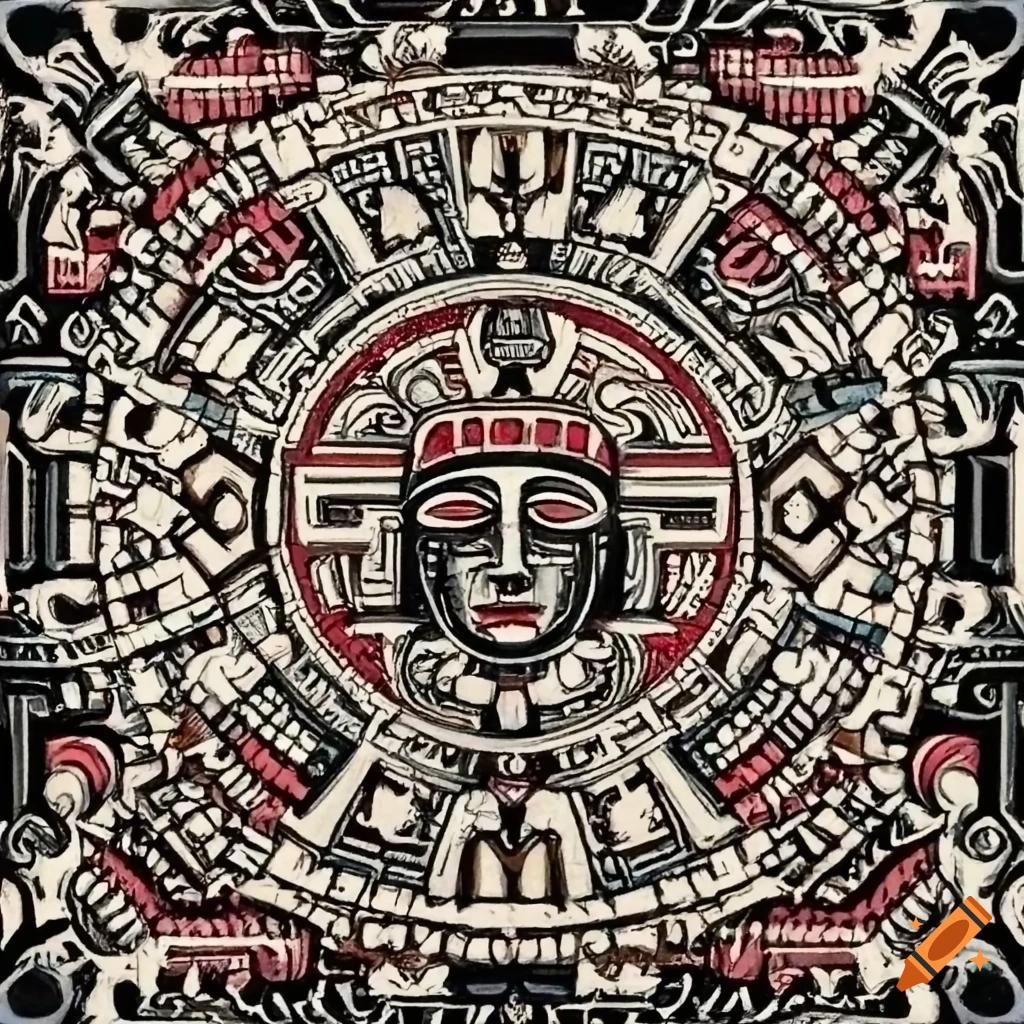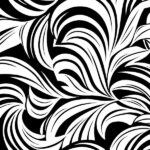Aztec Patterns Unveiled: A Journey through Ancient Symbols and Cosmic Connections
Key Takeaways:
- Ancient Symbolism: Aztec patterns are not merely decorative; they are a visual language conveying cosmic connections, societal roles, and a deep reverence for nature and spirituality.
- Masterful Craftsmanship: Aztec artisans showcased unparalleled skill in weaving, pottery, and mural painting, infusing their patterns with symbolic meaning and cultural narratives.
- Timeless Influence: From ancient Mesoamerica to the contemporary global stage, Aztec patterns have transcended time, influencing fashion, design, and digital art.
- Cultural Sensitivity: As Aztec patterns gain popularity, it’s essential to approach their use with respect, understanding the historical and cultural significance and supporting responsible consumption and collaboration with indigenous communities.
- Living Legacy: Aztec patterns continue to evolve, seamlessly integrating into modern lifestyles, bridging the gap between ancient traditions and contemporary expressions.
Introduction
Aztec patterns, a mesmerizing tapestry of vibrant colors and intricate designs, stand as a testament to the rich cultural heritage of the Aztec civilization. This four-part exploration delves into the origins, symbolism, and evolution of Aztec patterns, unraveling the stories woven into every thread.
Unveiling the Rich Heritage of Aztec Patterns
Historical Roots of Aztec Patterns:
The Flourishing Aztec Civilization: The Aztec civilization, flourishing between the 14th and 16th centuries in Mesoamerica, left an indelible mark on art, architecture, and design. At the heart of their creative expression were the awe-inspiring Aztec patterns, reflecting a society deeply connected to nature, spirituality, and a complex social hierarchy.
Influence of Nature: Aztec patterns draw inspiration from the diverse landscapes that surrounded the civilization – from the towering mountains to the lush jungles. Geometric shapes, stylized flora, and fauna were meticulously integrated into their art, capturing the essence of the natural world. The intricate details in their patterns reflect the Aztecs’ keen observation of their environment.
Spiritual Significance: Central to Aztec life was a profound spirituality, and this transcendent connection found its way into their patterns. Symbols of gods, mythological creatures, and celestial elements adorned textiles and pottery. Each pattern held a deeper meaning, serving as a visual language that communicated their beliefs, rituals, and cosmology.
The Evolution of Aztec Patterns:
From Antiquity to Modernity: Aztec patterns have withstood the test of time, transcending the boundaries of ancient Mesoamerica to become a global aesthetic phenomenon. The evolution of these patterns can be traced through the ages, with influences from Spanish colonization, artistic movements, and contemporary design seamlessly interwoven into their fabric.
Spanish Influence and Adaptation: The arrival of the Spanish conquistadors in the early 16th century marked a significant turning point for Aztec art. While the Spanish imposed their cultural influence, Aztec artists adapted their traditional patterns to include elements of European design. This fusion gave rise to a unique blend of styles, creating a visual dialogue between two worlds.
Revival in the 20th Century: Aztec patterns experienced a renaissance in the 20th century, capturing the imagination of artists, fashion designers, and architects worldwide. The geometric precision, bold colors, and spiritual motifs resonated with the modern aesthetic sensibilities. From haute couture runways to contemporary interior design, Aztec patterns became a symbol of cultural fusion and timeless elegance.
Contemporary Resurgence: In the 21st century, Aztec patterns continue to influence and inspire. The resurgence of interest in traditional crafts and indigenous art has brought Aztec motifs into mainstream consciousness. With a renewed appreciation for cultural diversity, designers and consumers alike embrace Aztec patterns for their visual allure and cultural significance.
Decoding the Symbolism within Aztec Patterns
As we embark on the second leg of our journey into the captivating world of Aztec patterns, we delve into the symbolism that breathes life into each intricate design. From cosmic connections to societal roles, Aztec patterns tell a profound story through their visual language.
Cosmic Symbolism in Aztec Patterns:
Sun, Moon, and Stars: At the heart of Aztec cosmology was the reverence for celestial bodies, and this cosmic admiration found expression in their patterns. The sun, as a symbol of life and energy, often takes center stage, radiating in geometric brilliance. Moon patterns, representing femininity and the night, provide a beautiful contrast, while stars twinkle across textiles like distant promises.
Quetzalcoatl and Serpent Imagery: The deity Quetzalcoatl, often depicted as a feathered serpent, plays a pivotal role in Aztec mythology. This iconic imagery is seamlessly integrated into their patterns, symbolizing creation, wisdom, and the cyclical nature of existence. The serpent, as a symbol of transformation and rebirth, weaves through the intricate designs, offering a glimpse into the Aztec worldview.
Societal and Ritualistic Symbolism:
Hierarchy and Social Status: Aztec society was structured with a complex hierarchy, and this social order found reflection in their patterns. The attire of rulers and nobility boasted elaborate and ornate designs, showcasing their elevated status. Commoners, on the other hand, adorned simpler patterns, marking the distinctions within the social fabric.
Warriors and Rituals: Aztec warriors, esteemed for their bravery, often wore patterns that spoke of their achievements in battle. Symbols of jaguars, eagles, and war god Huitzilopochtli adorned their garments, underscoring their valor and connection to the divine. Ritualistic patterns, employed during ceremonies and celebrations, added a layer of spirituality to communal events.
Colors as Symbolic Elements:
Rich Palette of Significance: The vibrant colors within Aztec patterns are not mere aesthetic choices but hold deep symbolic meanings. Red, symbolizing life and vitality, often represented the sun and the heart. Blue, associated with the divine and water, reflected the cosmic and earthly realms. Yellow and gold, embodying maize and abundance, spoke of prosperity and agricultural bounty.
Continuity of Symbolism in Contemporary Design:
Modern Interpretations: In contemporary design, the symbolism within Aztec patterns has not been lost. Artists and designers pay homage to the rich cultural tapestry by incorporating these ancient symbols into their creations. Whether in fashion, home decor, or digital art, Aztec symbolism continues to transcend time, offering a visual bridge between the ancient and the modern.
Crafting Aztec Patterns – Techniques and Artistry
As we venture into the third part of our exploration into Aztec patterns, we unravel the meticulous craftsmanship and artistic techniques that define this ancient tradition. From textile artistry to pottery embellishments, Aztec patterns showcase a mastery of form and color that continues to captivate the imagination.
Textile Artistry:
Weaving Traditions: At the heart of Aztec textile art lies the ancient tradition of weaving. Skilled artisans meticulously wove intricate patterns into fabrics using backstrap looms. These looms, simple in design yet versatile, allowed for the creation of elaborate textiles with geometric precision. The resulting patterns adorned garments, blankets, and ceremonial attire, reflecting the richness of Aztec culture.
Natural Dyes: The vibrant hues in Aztec patterns were derived from a palette of natural dyes. Aztec artisans sourced colors from plants, minerals, and insects, creating a spectrum that ranged from earthy browns to vivid blues and reds. The use of cochineal insects, for instance, produced a brilliant red dye, adding a touch of natural splendor to their creations.
Pottery Embellishments:
Detailed Ceramics: Aztec pottery was another canvas for the expression of intricate patterns. Skilled potters adorned vessels with geometric designs, mythological symbols, and scenes from daily life. The precision in carving and painting showcased the technical prowess of Aztec artisans, turning utilitarian objects into works of art.
Symbolism in Ceramics: Beyond their aesthetic appeal, Aztec pottery often carried symbolic meaning. Vessels used in rituals depicted gods, animals, and cosmological elements, reinforcing the spiritual connection between the Aztecs and the divine. The marriage of functionality and symbolism elevated Aztec pottery to a realm where art and spirituality seamlessly intertwined.
Architectural Integration:
Mural Masterpieces: Aztec patterns extended beyond textiles and pottery to leave an indelible mark on architecture. Elaborate murals adorned temples, palaces, and public spaces, depicting scenes from mythology, astronomy, and daily life. The meticulous detailing in these murals reflected the Aztecs’ commitment to expressing their cultural narratives through various artistic mediums.
Influence on Modern Artisans:
Artisanal Revival: In the contemporary era, there has been a resurgence of interest in traditional craftsmanship and artisanal techniques. Aztec patterns, with their emphasis on handcrafted excellence, have inspired modern artisans. From handwoven textiles to intricately painted ceramics, the techniques employed by Aztec artisans continue to influence and shape the work of contemporary creators.
Aztec Patterns in Modern Fashion and Design
In our final installment, we turn our gaze to the contemporary landscape, exploring how Aztec patterns have transcended time and geographical boundaries, influencing modern fashion, design, and cultural expression.
Fashion Resurgence:
Runways and Street Fashion: Aztec patterns have found a dynamic resurgence on global fashion runways and in streetwear. Designers draw inspiration from the geometric precision and vibrant color palettes, incorporating Aztec motifs into clothing, accessories, and footwear. This fusion of ancient aesthetics with modern style creates a visually striking and culturally rich tapestry in the world of fashion.
Global Appeal: The global appeal of Aztec patterns lies in their versatility. Whether it’s a bold geometric print on a jacket, a subtle embroidery detail on a dress, or an accessory adorned with ancient symbols, Aztec-inspired fashion resonates with individuals seeking a connection to cultural heritage and a unique, eye-catching aesthetic.
Interior Design Elegance:
Aztec Motifs in Home Decor: Aztec patterns have seamlessly transitioned into interior design, adorning homes with a touch of cultural sophistication. From rugs and throws to wallpaper and furniture, the intricate designs bring a sense of warmth and visual intrigue to modern living spaces. The timeless quality of Aztec patterns allows them to complement various design styles, from minimalist to eclectic.
Artistic Fusion: Modern artisans and interior designers often blend Aztec patterns with contemporary elements, creating a harmonious fusion of the ancient and the new. Whether it’s a mural on a feature wall or patterned tiles in a kitchen, Aztec-inspired design adds layers of meaning and cultural richness to living spaces.
Digital Expression:
Aztec Patterns in Digital Art: The digital realm has not been untouched by the influence of Aztec patterns. Digital artists incorporate these motifs into their creations, exploring new dimensions of expression. From intricate digital illustrations to animated designs, Aztec patterns continue to evolve and adapt to the ever-changing landscape of artistic innovation.
Cultural Appreciation and Sensitivity:
Ethical Considerations: As Aztec patterns gain popularity in the global market, it becomes crucial to approach their use with cultural sensitivity and awareness. Responsible consumption involves understanding the historical and cultural significance of these patterns, respecting their origin, and acknowledging the communities from which they emerged.
Collaborative Initiatives: Some fashion and design brands actively collaborate with indigenous artisans and communities, ensuring that the appreciation of Aztec patterns goes beyond aesthetics. These collaborations contribute to the preservation of traditional craftsmanship and provide economic support to the communities that uphold these artistic legacies.
Conclusion
In the final stretch of our exploration into Aztec patterns, we witness the seamless integration of ancient artistry into the modern world. From fashion runways to living room walls, Aztec patterns endure as more than just visual elements – they are threads connecting the past to the present, cultural symbols weaving a narrative that spans centuries. As we navigate the contemporary landscape, the beauty and significance of Aztec patterns persist, a testament to the enduring legacy of this ancient Mesoamerican civilization.


